Introduction
Anthocyanin can be found in many types of flowers, fruits and vegetables which having color of red or orange and blue. For example, the total content of anthocyanin was 6.8 mg/g in wild cherries, 6.7 mg/g in elderberries, 4.5 mg/g in cultivated bilberries, 3.5 mg/g in wild bilberries, 1.3 mg/g for cultivated cherries 1.0 mg/g for cultivated blackberries and 0.8 mg/g for cultivated strawberries.1 Anthocyanin can be a strong antioxidant and exhibits positive antiviral, anti-inflammatory as well as to decrease capillary permeability, fragility, inhibit platelet aggregation and stimulation of the immune system.2 Interest in anthocyanin becomes increasing because of it health benefits as dietary antioxidants and anthocyanin extracts from fruits and vegetables are marketed as dietary supplements and as a natural colorant to replace some synthetic colorants. Anthocyanin has a high scavenging activity towards chemically generated reactive oxygen species (ROS) and reactive nitrogen species (RNS), but this activity may be less correlated with their antioxidant properties.3 Sáyago-Ayerdi et al.,4 evaluated the anthocyanins from various fruits and vegetables for their antioxidative effect in meat products and showed that they can improve the oxidative stability of cooked chicken, dry-fermented sausage and cooked beef. Recently, anthocyanins extracted from roselle and commercial anthocyanin powder (black carrots and grapes skin) have been reported to be an effective antioxidant in terms of antilipoperoxidant activity in ethnic meat products including Chinese-style sausages and pork chops. Studies on the reactive nitrogen species scavenging capacity of anthocyanins from roselle are rare, even it has a high anthocyanin content of 622.91 mg/100g, the amount of roselle anthocyanin extract using in Chinese-style sausages was 0.3%, therefore this amount of RAE (0.3%) was selected for further study.
Sodium or potassium nitrate/nitrite is commonly used in meat preservation, to produce a reddish pink color, improve flavor, inhibit the formation of Clostridium botulinum spores and prevent lipid oxidation and rancidity.5 However, when not sufficiently controlled, nitrate or nitrite can be carcinogenic. The residual nitrate or nitrite levels are affected by heating during processing, storage time and temperature, packaging, gamma irradiation and hurdle technology.6,7 Several studies have been reported on the use of vegetable juice powder8, orange fiber, tomato paste and citrus co-product9 as meat ingredients that exhibited high potential for nitrite reduction in ham, hotdogs and sausages. There are no specific reports on the use of anthocyanin in meat products to reduce the residual nitrites, hence the objective of this study was to test the scavenging ability of anthocyanin extracted from the calyces of roselle (Hibiscus sabdariffa L.), kra-jeab in Thai, on reactive nitrogen species and their potential use for reducing nitrites in meat products. Additionally selected anthocyanin extracted from black carrots and red grapes were tested to compare the RNS scavenging activities with those of roselle as well.
Materials and Methods
Anthocyanins and Chemicals
The reagents and solvents were supplied by Sigma Chemical Co. (St. Louis, MO, USA) and Merck (Darmstadt, Germany) and were all of analytical grade. Anthocyanins from grapes skins (AC 12 WSP, Christian Hansen) and black carrots (ColorFruit Carrot 12 WSP, Christian Hansen) were used for the comparative study.
Roselle extracts preparation
Dried roselle calyces were purchased from a local market in Bangkok, dried, and crushed finely in a blender (Moulinex type AAW9, Indonesia). This roselle powder (20 g) was soaked for 24 hr in 95% ethanol (1:10 w/v) while shaking to increase the extraction efficiency and then filtered (Whatman No.1 filter paper) and the filtrate evaporated in a rotary evaporator (Büchi model R210, Switzerland) at 30๐C until the ethanol was removed. The crude extract was stored in a tightly closed brown bottles at -25 ๐C.
Meat products preparation
Preparation of meat products, Vienna sausage and traditional Thai fermented pork sausage called Nham, followed the method described by Heinz and Hautzinger10 and Swetwiwathana et al.,11 The 0.3% roselle extracts was chosen according to preliminary study showing significantly slow down lipid oxidation and, either 125 and 250 mg/kg sodium nitrite were used as controls. The justification for these levels is that 125 mg/kg sodium nitrite is the highest permitted level for use in meat products in Thailand (TISI 1219/2004) and 250 mg/kg represented a worst-case scenario.
The Vienna sausage mixtures were stuffed into collagen casing (Nippi casing, Japan), linked into 10 cm length and dried at 60±2๐C for 1 hr, then cooked in hot water (65±2๐C) for 45 min. After cooling, the sausages were packed under vacuum in 80 µ thick laminated vacuum bags (polyamide/linear low-density polyethylene/low-density polyethylene), stored at 4±1๐C and analyzed every 3 days for 24 days. For the Nham, 100 g of the mixtures were stuffed into 2.5 cm diameter polyethylene bags and tied with thread. The samples were then fermented at room temperature (30±1๐C), producing lactic acid, and analyzed every day for 7 days.
Measurement of reactive nitrogen species (RNS) scavenging capacities of anthocyanin
Sodium nitrite scavenging activity
Assays of nitrite scavenging activity was carried out using modifications of the method previously described. 12,13 The anthocyanins were first diluted in water to concentrations in the range of 0.1 to 1.0 mg/ml and then 3 ml of each anthocyanin solution was mixed with 0.1 ml of sodium nitrite solution (200 μg/ml) and 0.1 mol/dm3 of citrate/phosphate buffer (pH 3.0 and pH 6.0) or sodium carbonate/sodium bicarbonate buffer (pH 9.0) and made up to the final volume of 10 ml. The mixture was immediately incubated in a water bath at 37±1°C for 60 min and 1 ml of each reaction mixture was mixed with 1 ml of Griess reagent (1% sulfanilamide and 0.1 % N-(1-naphthyl)-ethylamine diamine hydrochloride in 2.5 % phosphoric acid). The absorbance was determined after 10 min using a spectrophotometer (Shimadzu UV-1601, Japan) at 538 nm. The control (Acontrol) (without sodium nitrite solution) and the standard (Astandard) (without both the sodium nitrite solution and the pigment sample) were also measured. Butylated hydroxyanisole (BHA) and ascorbic acid and were used as the positive control compounds.14,26 The following formula was used to calculate the sodium nitrite scavenging activity:
Sodium nitrite scavenging (%) = [Astandard – (Asample – Acontrol) / Astandard] x 100
Nitric oxide scavenging activity
A spectrometer was used to measure the nitric oxide scavenging activity according to method described by Govindarajan et al.,15 where the reaction mixture, containing dose of the anthocyanins solution in the range of 10-160 μg/ml and 10 mol/dm3 sodium nitroprusside in 20 mol/dm3 phosphate buffer saline (pH 7.4) was made up to a volume of 3 ml and immediately incubated in a water bath at 25±1 °C for 150 min. The same reaction mixture, but without the anthocyanins solution, was used as the control. Each anthocyanin solutions (0.5 ml) was mixed with 2 ml of Griess reagent and incubated at 25±1°C for 1 hr. The pink chromophore, generated during diazotization of nitrite ions with sulphanilamide and subsequent coupling with N-(1-naphthyl)-ethylene diamine, was measured at 540 nm. Ascorbic acid and BHA were used as the positive control compounds. The following formula was used to calculate nitric oxide scavenging ability16:
Nitric oxide scavenging (%) = [A540nm of control – A540nm of sample / A540nm of control] x 100
Peroxynitrite scavenging activity
The method described by Beckman et al.,17 was used for the synthesis of peroxynitrite (ONOO−) where an acidic solution (2.11 mol/dm3 hydrogen peroxide in 1.85 mol/dm3 nitric acid) was mixed with 5 ml of 2 mol/dm3 sodium nitrite in an ice bath and 5 ml of ice-cold 4.2 mol/dm3 sodium hydroxide was added to the reaction mixtures. Excess hydrogen peroxide was removed by treatment with granular manganese dioxide that had been pre-washed with 1.2 mol/dm3 sodium hydroxide. The reaction mixture was left overnight at -20 °C and then diluted 20 times in 0.1 mol/dm3 sodium hydroxide and the absorption spectrum between 240 and 400 nm was measured. An absorption band at 302 nm should be evident. The concentration of peroxynitrite was calculated by using the formula ![]()
The Evans blue bleaching assay, described by Bailly et al., 18 with a slight modification, was used to measure peroxynitrite scavenging activity. The reaction mixture that was added to various doses of anthocyanins solution (over the range of 0 to 200 µg/ml) contained 20 mol/dm3 phosphate buffer (pH 7.4), 0.1 mol/dm3 diethylenetriamene penta acetic acid, 90 mol/dm3 sodium chloride, 5 mol/dm3 potassium chloride, 12.5×10-3 mol/dm3 Evans blue, 1 mol/dm3 peroxynitrite and was made up to a final volume of 1 ml. The absorbance was measured using a spectrophotometer (Shimadzu UV-1601, Japan) at 608 nm after incubation at 25 °C for 30 min. All tests were carried out six times and gallic acid was used as the reference compound. Scavenging % of peroxynitrite was calculated by comparing the results of the anthocyanins and blank samples as follows:
Peroxynitrite scavenging (%) = [A0 – A1 / A0] x 100
Where: A0 = absorbance of the control
A1 = absorbance in the presence of anthocyanins or reference compounds.
Thiobarbituric acid reactive substances (TBARS) measurement
Thiobarbituric acid reactive substances (TBARS) were determined using the method modified from Min et al.,19 where 5 gram sample was used and homogenized with 15 ml of deionized distilled water using a homogenizer (Ultra-TurraxÒ T25B basic, Germany). A sample homogenate (1 ml) was transferred to a test tube to which 50 µl of butylated hydroxyanisole (10%) and 2 ml TBA/trichloroacetic acid were added. Then the mixture was vortexed and incubated in boiling water for 15 min to develop its color, cooled in cold water for 5 min, vortexed again and finally centrifuged for 10 min at 20,000xg (Hettich Universal 16, Germany)20. The absorbance of the resulting supernatant solution was determined at 532 nm against a blank containing 1 ml of deionized distilled water and 2 ml of TBA/trichloroacetic acid solution. The amounts of TBARS were expressed as milligrams of malondialdehyde per kilogram of sample. A standard curve was prepared using 1,1,3,3 tetramethoxypropane. The residual nitrite in the samples was measured according to the method of Liu et al.,21 Ground sausage samples (2-5 g) were homogenized with 100 ml of distilled water at 80°C in a 250 ml flask for 30 sec at high speed, using a homogenizer (Ultra-TurraxÒ T25B basic, Germany). The homogenate was washed with distilled water and made up to 150 ml, sealed with an aluminium foil cap and heated for 30 min in water bath at 80 °C with an occasional shaking to increase the extraction efficiency. After cooling in iced water to room temperature and filtering (Whatman No. 1), 10 ml of filtrate and 2 ml of Griess solution were transferred into a test tube, covered with aluminium-foil, allowed to stand at room temperature for 30 min and the absorbance was measured using a spectrophotometer (Shimadzu UV-1601, Japan) at 540 nm. The calibration curve was constructed by plotting absorbance verses concentration of sodium nitrite over the range of 0 to 20 mg/kg.
Statistical Analysis
Data was analyzed by one-way ANOVA using SPSS and the results are expressed as the mean ± standard deviation (n=6) and significant differences were calculated at p£0.05. All measurement and trials were tested in triplicate.
Results and Discussion
Anthocyanins from all plant sources and the reference compounds exhibited nitrite scavenging activity but the level depended on concentration and pH with the greater activities at the higher concentration and lower pH. All anthocyanin samples showed similar activity in scavenging of nitrite and also similar to that of vitamin C. In addition, greater activities were found for the three anthocyanin samples compared to BHA (Figure 1).
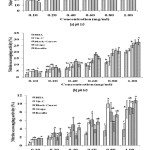 |
Figure 1: Nitrite scavenging activity, measured as IC50 (half maximal inhibitory concentration), Bars with different letters are significantly different (p£0.05) |
The effect of pH can be clearly observed from the IC50 values which refer to the concentration of the tested sample at which the nitrite scavenging activity equals to 50%. The IC50 of roselle anthocyanin extracts reduced about 7 times, when pH of the reaction mixtures decreased from pH 9.0 to pH 3.0. Similar results could also be seen for all other samples and reference compounds which is in agreement with previous studies reported that nitrite scavenging activities of the ethanol extracts of bamboo oil were > 90% and > 50% at pH 1.2 and 3.0, respectively and were even lower at pH 4.2 and 6.0. More specifically, the nitrite scavenging activity of green tea extracts, Sonchus oleraceus L. extracts and citrus peel powder decreased with the increase of pH and the activity was greatest at pH levels lower than 3.0. The nitrite scavenging activity of RAE was also confirmed in the model of meat products to be influenced by pH and will be discussed later.
Among the three anthocyanin extracts studied, anthocyanins extracted from roselle exhibited slightly higher nitric oxide scavenging activity compared to black carrots and grapes (Figure 2). The anthocyanins from black carrots had slightly lower activity compared to those from grapes and roselle extracts at the concentration 20 to 200 mg/ml (Figure 3). Generally, the ability of all anthocyanin samples in scavenging of peroxynitrite was similar to that of standard gallic acid.
The peroxynitrite scavenging properties of anthocyanin, especially pelargonidin, has been previously reported by Tsuda et al.,22 It has also been shown that the activity of anthocyanins in perxynitrite scavenging at pH 7.4 decreased in the following order: delphinidin > cyaniding » petunidin > malvidin » (-)-catechin > peonidin > pelargonidin. Black carrots and grapes mainly consist of cyaniding-based pigments, while roselle consists of mostly delphinidin. This indicates that roselle would be a good source of anthocyanins with strong peroxynitrite scavenging activity. However, results in Figure 3 did not clearly show the strong scavenging activity of RAE compared to anthocyanins from black carrots and grapes. This could be due to the RAE used in this experiment was a crude ethanolic extract, while the anthocyanins from black carrots and grapes were commercial samples.
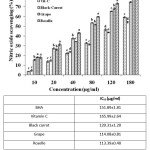 |
Figure 2: Nitric oxide scavenging activity of anthocyanins from roselle, black carrot and grape. Bars with different letters are significantly different (p£0.05). Click here to View figure |
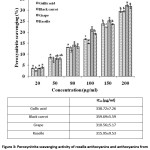 |
Figure 3: Peroxynitrite scavenging activity of roselle anthocyanins and anthocyanins from black carrot and grape. Bars with different letters are significantly different (p£0.05). Click here to View figure |
The TBARS values of all the Vienna pork sausage samples increased with the increasing of storage time (Figure 4a). However, when the Vienna pork sausages had been treated with RAE and 125 or 250 mg/kg sodium nitrite they had significantly lower (p<0.05) TBARS values compared to those without RAE and the reference samples (with BHA). In the control samples, there was a tendency of lower TBARS values for the sausage with the higher level of sodium nitrite (250 mg/kg). Fernandez et al., previously showed that the presence of nitrite in the meat products could reduce the TBARS value.23 However, the concentration effect of sodium nitrite on its antioxidant activity was not clearly observed in both reference samples and samples with RAE addition. On the other hand, sausages with BHA addition tended to have higher TBARS values at higher concentration of sodium nitrite.
The residual nitrite in all sausage samples tended to decreased with longer storage time and the reduction of nitrite level was more pronounce in the samples with 250 mg/kg initial sodium nitrite (Figure 4b). In the control sausages (without RAE), residual nitrite levels were reduced from 250 mg/kg to about 180 mg/kg after 24 days of refrigerated storage. The reference samples with BHA addition also showed similar results in residual nitrite reduction during storage compared to the controls. Sausages with RAE addition clearly showed that RAE was more efficient in reduction of residual nitrite. The nitrite levels reduced 67.73 % and 52.46 % for the RAE treated sausages with 250 and 125 mg/kg of initial sodium nitrite, respectively. Lipid oxidation continuously increased for all samples of Nham during fermentation (Figure 5a). In the control samples, Nham with 125 mg/kg initial sodium nitrite had significantly higher TBARS values than Nham with 250 mg/kg initial sodium nitrite. This result clearly showed the antioxidant activity of sodium nitrite. However, the effect of nitrite concentration on TBARS values of the reference sample (with BHA) and RAE treated sample was not clear. Results also showed that RAE could prevent the lipid oxidation in Nham similar to BHA at the fermentation time within 3 days. With the independence of the initial nitrite concentration, the residual nitrite in all Nham samples had reduced to lower than 20 mg/kg after 3 days of fermentation (Figure 5b). The pH values of all Nham samples after 3 days of fermentation decreased from 5.9 to about 4.4 (data not shown).
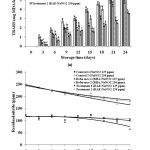 |
Figure 4: TBARS values (a) and residual nitrite (b) of Vienna pork sausage samples during storage at 4±1 °C. Bars with different letters are significantly different (p£0.05). Click here to View figure |
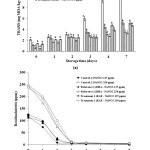 |
Figure 5: TBARS values (a) and residual nitrite (b) of Nham samples during fermentation at 31±1°C. Bars with different letters are significantly different (p£0.05). Click here to View figure |
Comparing to the results observed in the Vienna pork sausage (data not shown), the rapid reduction of residual nitrite in Nham was most likely to be due to the acidic pH caused by lactic acid fermentation. Nitrite depletion rate in meat products was previously shown to be dependent upon product formulation, pH, time/temperature relations during processing and storage time and conditions. A similar effect of pH on the nitrite reduction in vitro was reported by Wang et al.,24 who found that the nitrite lost was about 98.5 % at pH 3.0, while the loss was only 60-68 % at pH between 4.0 to 5.0. The residual nitrite in all samples of Nham reduced up to 90 % at pH around 4.5. The over reduction of residual nitrite observed in Nham samples with RAE or BHA addition was also, in part, due to the nitrite scavenging activity of RAE and BHA (Figure 5b).
Surprisingly, the control samples (without RAE and BHA) showed the similar results of residual nitrite depletion. This might be due to the effect of fresh garlic which was used at about 4.3 % as an ingredient in the Nham formula. Sun et al.,25 reported that 5 % fresh garlic and 1.2 % garlic powder could reduce residual nitrite in cured Chinese sausage. The nitrite reduction observed in the Nham samples was in agreement with the finding reported by Samelis et al.,26 traditional Greek salami sausage, which was rapidly decreased from the initial level of 250 mg/kg to < 10 mg/kg within 3 days. Also the residual nitrite found in Turkish style sausage was also in the range of 4 to 11 mg/kg after 3 day ripening.27
Conclusions
Roselle anthocyanin extracts and anthocyanins from black carrots and grapes exhibited strong scavenging activity of reactive nitrogen species. The in vitro study showed that the pH-dependence for the nitrite scavenging property of RAE had higher activity at lower pH. The effect of pH level on nitrite reduction was also confirmed in the models of meat products including Vienna pork sausage and Nham. According to the kinetic parameters of nitrite degradation in the Nham model, RAE could be used to enhance the residual nitrite reduction in the meat products.
Conflict of Interest
All the authors have declared no conflict of interest.
Acknowledgements
The authors would like to thank the Office of the National Research Council of Thailand (NRCT) for the part of financially support and The East Asiatic (Thailand) Public Company Limited for anthocyanins support during the development of this scientific work.
References
- Zlatan R., Jasmin T. and Tahirovic I. Total content of phenols and anthocyanins in edible fruits from Bosnia. of Basic Med Sci. 2007; 7(2): 117-120.
CrossRef - Zafra-Stone S., Yasmin T., Bagchi M., Chatterjee A., Vinson J.A. and Bagchi D., Berry anthocyanins as novel antioxidants in human health and disease prevention. Mol Nutr Food Res. Special Issue: Berry Fruits. 2007; 51(6): 675-683.
CrossRef - Ichiyanagi T., Hatano Y., Matsugo S. and Konishi T. Reactivity of anthocyanin toward reactive oxygen and reactive nitrogen species. In Yoshikawa, T., Hiramatsu, M. and Packer, L. (Eds.). Molecular Interventions in Lifestyle-Related Diseases. 2006 (pp: 339-345). Boca Raton: CRC Press.
CrossRef - Sáyago-Ayerdi S.G., Brenes A. and Goñi I. Effect of grape antioxidant dietary fiber on the lipid oxidation of raw and cooked chicken hamburgers, LWT – Food Sci and Tech. 2009; 42(5): 971-976.
CrossRef - Pegg R.B. and Shahidi F. 2000. Nitrite Curing of Meat. The N-nitrosamine problem and nitrite alternatives. Connecticut: Food and Nutrition Press. Inc.
- Jafari M. and Emam-Djomeh Z. Reducing nitrite content in hot dogs by hurdle technology. Food Control. 2007; 18(12): 1488-1493.
CrossRef - Ahn H.J., Kim J.H., Jo C., Lee C.H. and Byun M.W. Reduction of carcinogenic N-nitrosamines and residual nitrite in model system sausage by irradiation. J of Food Sci. 2002; 67(4): 1370-1373.
CrossRef - Kang H.J., Chawla S.P., Jo C., Kwon J.H. and Byun M.W. Studies on the development of functional powder from citrus peel. Bioresour Technol. 2006; 97(4): 614-620.
CrossRef - Paari A., Naidu H.R., Kanmani P., Satishkumar R., Yuvaraj N., Pattukumar V. and Arul V. Evaluation of irradiation and heat treatment on antioxidant properties of fruit peel extracts and its potential application during preservation of goat fish Parupenaeus indicus. Food Bioprocess Tech. 2011; 5(5): 1860-1870.
CrossRef - Heinz G. and Hautzinger P. Meat processing technology: for small- to medium scale producers. Food and Agriculture Organization of the United Nations (FAO), Regional Office for Asia and the Pacific (RAP), 2007. Bangkok. Thailand.
- Swetwiwathana A., Lotong N., Nakayama J. and Sonomoto K. Maturation of Nham – a Thai fermented meat produc: Effect of Pediocin PA-1 producer (Pediococcus pentosaceus TISTR 536) as starter culture, nitrite and garlic on Salmonella anatum during Nham fermentation. Fleischwirtschaft International. 2007; 22(3): 46-49.
- Rahman M.M., Ichiyanagi T., Komiyama T., Hatano Y. and Konishi T. Superoxide radical- and peroxynitrite-scavenging activity of anthocyanins; structure-activity relationship and their synergism. Free Radical Research. 2006; 40(9): 993-1002.
CrossRef - Parinyapatthanaboot T. and Pinsirodom P. Effect of Xylitol Concentration on Oxidative Stability and Quality Parameters of Roselle Anthocyanin Added Chinese-style Sausage. In Proceedings of The 12th Asean Food Conference 2011, June 16-18, Bangkok, Thailand.
- Viuda-Martos M., Fernández-López J., Sayas-Barbera E., Sendra E., Navarro C., and Pérez-Álvarez J.A. Citrus co-products as technological strategy to reduce residual nitrite content in meat products. J of Food Sci. 2009; 74(8): 93-100.
CrossRef - Govindarajan R., Rastogi S., Vijayakumar M., Rawat A.K.S., Shirwaikar A., Mehrotra S. and Pushpangadan, P. Studies on the antioxidant activities of Desmodium gangeticum. Biol Pharm Bull. 2003; 26(10): 1424-1427.
CrossRef - Keeton J.T. History of Nitrite and Nitrate in Food. 2011 Springer, New York.
CrossRef - Beckman J.S., Chen J., Ischiropoulos H. and Crow J.P. Oxidative chemistry of peroxynitrite. Meth Enzymol. 1994; 233: 229-240.
CrossRef - Bailly F., Zoete V., Vamecq J., Catteu J.P. and Bernier J.L. Antioxidant actions of ovothiol-derived 4-mercaptoimidazoles: glutathione peroxidase activity and protection against peroxynitrite-induced damage. FEBS Letters. 2000; 486(1): 19-22.
CrossRef - Min B., Chen M.H. and Green B.W. Antioxidant activities of purple rice bran extract and its effect on the quality of low-NaCl, phosphate-free patties made from channel catfish (Ictalurus punctatus) belly flap meat. J of Food Sci. 2009; 74(3): 268-277.
CrossRef - Saha K., Lajis N.H. and Israf D.A. Evaluation of antioxidant and nitric oxide inhibitory activities of selected Malaysian medicinal plants. J Ethnopharmacol. 2004; 92(2-3): 263-267.
CrossRef - Liu D.C., Wu S.W., and Tan F.J. Effects of addition of anka rice on the qualities of low-nitrite Chinese sausages. Food Chem. 2010; 118(2): 245-250.
CrossRef - Tsuda T., Kato Y. and Osawa T. Mechanism for the peroxynitrite scavenging activity by anthocyanins. FEBS Letters. 2000; 484(3): 207-210.
CrossRef - Fernández-López J., Viuda-Martos M., Sendra E., Sayas-Barberá E., Navarro C. and Pérez-Alvarez J.A. Orange fibre as potential functional ingredient for dry-cured sausages. Eur Food Res Technol. 2007; 226(2): 1-6.
CrossRef - Wang B.-S., Li B.-S., Zeng Q.-X. and Liu H.-X. Antioxidant and free radical scavenging activities of pigments extracted from molasses alcohol wastewater. Food Chem. 2008; 107(3):1198-1204.
CrossRef - Sun Y.M., Ockerman H.W. and Marriott N.G. Garlic in Chinese sausage. J Muscle Foods. 2000; 11(1): 35-43.
CrossRef - Samelis J., Metaxopoulos J., Vlassi M. and Pappa A. Stability and safety of traditional Greek salami – A microbiological ecology study. Int J Food Microbiol. 1998; 44(1-2): 69-82.
CrossRef - Üren A. and Babayiğit D. Color parameters of Turkish-type fermented sausage during fermentation and ripening. Meat Sci. 1997; 45(4): 539-549.
CrossRef

This work is licensed under a Creative Commons Attribution 4.0 International License.







